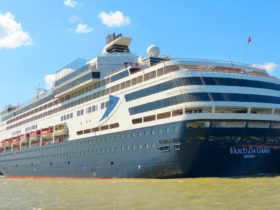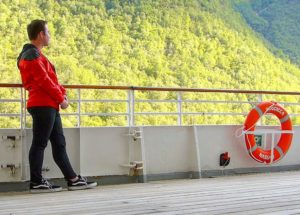When you think of a ferry, chances are Silja Serenade is not the first ship that initially comes to mind. Think of an innovative cruise ship, and you will probably think of a Royal Caribbean vessel, but did you know, these two share a closer connection to each other than you may have realised?
Silja Serenade is a passenger ferry operated by Finnish ferry brand Silja Line and owned by Estonian company Tallink. The ship operates between Helsinki, Mariehamn and Stockholm. Silja Serenade was ordered back in 1987 and entered service in 1990. It was constructed at the Turku shipyard in Finland.

In 1988, Royal Caribbean International had just launched the world’s largest cruise ship, Sovereign of the Seas – the first modern ‘megaship’ to be built. She featured a few ‘cruise firsts’ including the first multi-level atrium with glass elevators, and an entire deck dedicated to balcony accommodation. Sister ships Monarch of the Seas and Majesty of the Seas followed in 1991 and 1992.
1988 is also the year that Richard Fain became chairman of Royal Caribbean Cruises Ltd. He had always aimed to dispel the misconceptions surrounding cruising. He wanted to convince sceptical travellers that a cruise was far from outdated, boring or just for old people. The Sovereign-class was a step in the right direction, but Fain realised that Royal Caribbean needed to continue pushing the boundaries to help fix the cruise industry’s image problem.
To attract a new audience to even consider taking a cruise, he needed to create a new kind of ship. Something the world had never quite seen before, with new options and concepts. He wanted a ship that would be just as relevant and appealing in 10 or 20 years time. When Richard saw Silja Serenade he said ‘I’d like to have this kind of ship.’ At the time, the Royal Caribbean technical department said it couldn’t be built and that they would be better off commissioning another sister for the increasingly popular Sovereign class.


Fain was undeterred by this, and decided that if anyone could build his concept, it would be the original Finnish naval architect of Silja Serenade, Harri Kulovaara. He was responsible for Silja Serenade’s ground-breaking 150 metre, two-deck-high shopping promenade and its revolutionary layout, including huge glass windows over the aft, bringing plenty of natural daylight inside. Despite this, Silja Serenade remained a regional hidden gem, and the perfect platform for Royal Caribbean to build upon to create something even more special.

Richard Fain hired Harri Kulovaara in 1995 to help run the company’s shipbuilding department alongside Njål Eide, the Norwegian architect who helped design Sovereign of the Seas. “We’re not going to build that, Harri,” Fain told him. “We need something better.”
They began creating concepts under the ‘Project Eagle’ code name for an impressive 130,000 GT vessel, but they soon realised they needed to make the ship even larger at 142,000 GT to incorporate all of the elements they wanted. Harri and Fain worked closely with Turku shipyard to use elements of the Silja ship and improve upon some of those features first introduced on the ferry to create what we know today as the Voyager class.

Launched in 1999, Voyager of the Seas was $150m over the original $500m estimated cost. It was 75% larger than the previous largest cruise ship and a real feat of engineering, which helped shape the cruise ship building process and design to this day. Voyager of the Seas had a whole list of cruise ‘firsts’ – Harri’s Royal Promenade at the centre of the ship, lined with bars, shops, and eateries. The ship featured two banks of panoramic elevators and the first ice rink at sea. It also featured a rock climbing wall on the funnel – an idea Fain was not convinced on at first, but is now found on every Royal Caribbean ship.
Voyager of the Seas was soon followed by Explorer of the Seas (2000), Adventure of the Seas (2001), Navigator of the Seas (2002), and Mariner of the Seas (2003). The success of the Voyager class led Royal Caribbean to develop an enhanced extended version known as the Freedom class featuring Freedom of the Seas (2006), Liberty of the Seas (2007), and Independence of the Seas (2008). Harri’s revolutionary design and Fain’s forward-thinking vision also inspired the creation of the Oasis class in the late 2000s, featuring an even larger Royal Promenade and more impressive firsts.

Undeniably, the Voyager class changed the shape of the cruise industry. The new, much larger ships filled with exciting features, encouraged people to give cruising a chance and to experience it for themselves. And indeed, these ships are still inspiring people to do that to this day – over 20 years later.
It’s not just people though, Silja Serenade and the Voyager class has also inspired the creation of some other ships too. The Turku shipyard, which helped create the Voyager class ships, developed a new ferry version – a Silja Serenade 2.0. Taking exterior design elements, and internal features from the Voyager class they constructed a cruiseferry vessel for Nordic ferry operator Color Line. Color Fantasy, which launched in 2004 and sister ship Color Magic which launched in 2007 closely resembles the Voyager class in many ways – in fact many of the same building supplies and fittings were used on the ferry versions.

The bow section and forward superstructure is identical. The shopping promenade immediately feels like walking down a Royal Caribbean ship and an observation lounge very similar to the Viking Crown Lounge was repositioned towards the front of the ship, rather than around the funnel. The aft has a hint of the Radiance class and glass windows over the aft were inspired by Silja Serenade. In many way, the only difference between these ferries and the Voyager class is the lack of balconies and the addition of car decks.

Next time you’re in Scandinavia, why not take a mini cruise on one of these incredible ferries!

















Nice storyline. Well known for a Norwegian like me. But Color Fantasy was launched i 2004 and Color Magic in 2007. The ferries are Well kept and the wow-factor and ‘Rccl-feeling’ is still great!
Thank you Arne
Silja Serenade (and her sister Silja Symphony) really are great cruiseferries. Even now, some 30 years after their launch. I have made many trips on them from Stockholm to Helsinki and back. A perfect short get away with two nights aboard and a day in Helsinki (or Stockholm, if you go the other way).
I was happy to find this article. I always wondered if Serenade somehow inspired RC but had no idea that it was the same guy behind all this!
(BTW, it was said in the article that the Promenade on Serenade is two decks high but like can be seen in the image, it’s actually five.)